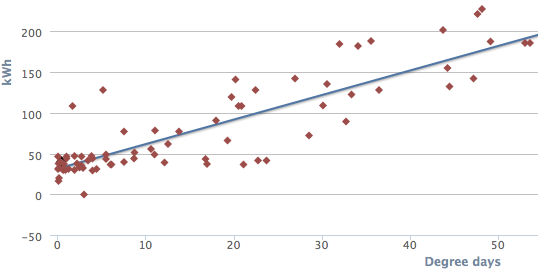Original URL: https://www.theregister.com/2011/11/15/greening_my_office/
My home is bugged ... with temp sensors to save me cash
Monitoring benefits of insulation
Posted in Science, 15th November 2011 11:00 GMT
Part 1 In the past, I've eulogised on the joy of metering and tuning my house, being money and carbon-neutral for gas and electricity at home, and my homegrown solar power.
This time I scout out new tech, describe upgrading the insulation in my boy's bedroom with aerogel and how I'm monitoring its performance with spiffy iButtons, and indeed keeping tabs on the whole house's performance with the free iMeasure website.
Energy solutions expo
Being a geek I want to know what goodies are on the horizon, so I popped into the Energy Solutions Expo at London's Olympia.
I was a bit unhappy at what I took to be a few large stands selling snake oil, but other than that one pleasing feature was the vast range of LED lighting in really huge sizes on show. When I started messing with them as an electronics hobbyist, LEDs were tiny feeble red things, not drop-in replacements for 400W of industrial lighting at a pop! A bit big for the average house.
There was a fair range of domestic-scale LED lighting on show too, as standard bulb-shape replacements for bayonet or screw-base incandescents (which are more robust, smaller and easier to fit than CFL low-energy bulbs) but also other fittings such as the MR16 (12V) and GU10 (240V) halogen spotlight style.
I took a couple of samples to review from istoriaLED, both 12V GU10 bulbs with an A+ energy rating and a lm/W (lumens per Watt, the most straightforward measure of lighting efficiency) of about 78, or 140 if you accept their "effective lumens" of 630 for the 4.5W in. One is "warm" (2,700K light temperature) and the other "cool" (6,000K).
The cool one certainly competes with my favourite ALTLED Aurora V3s and V5 (7W, 720lm), with the warm one significantly dimmer to my eye, more than I'd expect. (The 'warm' versions usually a few percent less efficient because they use a phosphor to convert some of the blue light to yellow, with some attendant losses.)
I'm running these off my unregulated off-grid 12V system, so I may not be experiencing them quite at their best, but I think that they are pretty good.
78lm/W is better than CFL efficiency, so upgrading a house's halogens to these is a real energy saver and avoids climbing on ladders every 5 minutes replacing blown ones: they may outlive you unless you're a spring chicken.
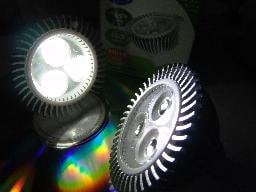
iStoria cold
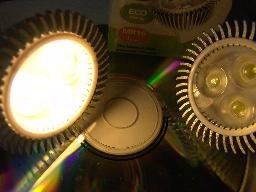
iStoria warm
Needs more aerogel
It's possible to do without any space or central heating at all in a sufficiently well-insulated and leak-proof home, such as a Passivhaus.
Such a set up would zap 75 per cent of our home gas consumption if we could do it, and while it's unlikely that my 40-odd-year-old timber-frame ex-council house can ever achieve that acme of performance, I just did another round aerogel of dry lining this month, which should more than bring the external wall performance up to the latest building regulations and reducing heat loss by a factor of three.
In this case I used slightly thinner aerogel (30mm, compared to 40mm in the living room downstairs) since the bedrooms are heated less of the time and to a lower temperature, and because space is at particular premium in the small room at barely over 2m in each dimension.
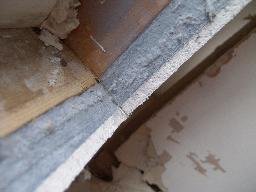
The three layers and blankets of aerogel behind
the magnesium board at the window
I also tried a different brand, Magnaline this time rather than Spacetherm, when faced with magnesium board. The builders said that the Magnaline's aerogel blanket was somewhat less inclined to snag drills and saws than Spacetherm. However, the lack of 'give' in the magnesium board made screws inclined to 'pop' and impossible to achieve a flush finish, which made keeping the surface level harder. All of which required extra plaster over the top to level out, taking away some of the planned space saving. But we still really only lost about an inch on one wall all told.
If you're really short of space then aerogel can get you to current building regs (a U-value of 0.3W/m2K for an exterior wall) in that inch or so, or for something like 1/10th the cost an alternative such as Kingspan K17 or K18 will do the same insulation in about twice the thickness, and you may be able to DIY it.
A major enemy of thermal performance is called thermal bridging, the equivalent of a short-circuit in electronics, letting all the heat out around your expensive insulation via a shortcut.
To avoid that, and because it took only slightly more insulation material, we cut through the partition wall into the next bedroom to slide the aerogel in behind it, thus avoiding the heat leaking out through the edge of the partition to the outside skin, and getting the first wall of the other child's bedroom done ready for some possible follow-up works next year.
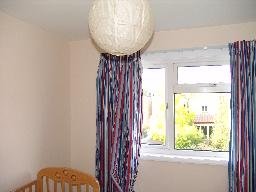
The finished wall, painted and with curtains up, in the small bedroom
Note that such energy-saving works potentially attract a reduced VAT rate of five percent on the hardware and labour, providing you keep them separate from any unrelated works going on at the same time - so get them invoiced separately.
iButton it: fitting a sensor array in your own home
In order to track the performance of the room, which now has extra insulation above and below too, I'm using four 15mm-diameter iButton Thermochron devices that automatically take up to 2,048 temperature samples at selectable intervals. I'm taking samples every 30 minutes for just over a month for "mission 1". The iButtons are small enough to be placed where the temperature is to be monitored, don't need any power or wires or clutter, and plug into a USB reader to download the readings.
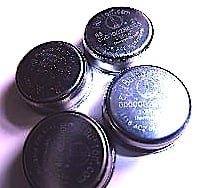
The four iButton sensors I'm using,
each about 15mm across
I have one button under the floor (which immediately showed up a huge draught coming in through the exterior wall below floor level), one in the room at about eye-level, one immediately above the plasterboard of the ceiling under the loft insulation, and one hanging in the loft above the insulation. I'm hoping to see how good my efforts are, aerogel and otherwise, at keeping the heat in the room and minimising demand from the radiators.
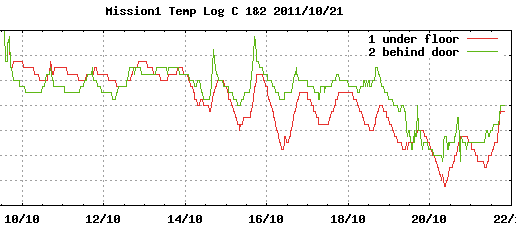
Initial readings from the first two buttons - one under the floor and another at about eye-height (Click to enlarge)
The drop in external temperature in mid-October is fairly evident from the graph from just the first two sensors, and the air leak under the floor letting sensor 1 get cold also stands out. That problem has now hopefully been obliterated with squirty foam; more readings will confirm or deny.
Stay tuned for more pretty graphs.
iMeasure, I manage
iMeasure.org.uk is a free site designed to help track your energy consumption at home. sMeasure.com is its SME (small business) counterpart, which I'm using to try to help my local school trim its energy use, too, and save some money in better ways.
All you have to do is enter your gas and electricity meter readings about once per week and the site will tell you how well you are doing and draw funky graphs, and do some quite sophisticated analysis. If you can measure, you can manage to save.
The clever thing to notice here is the normalisation against heating degree days, which allows you to work out how efficient you're being regardless of how cold the weather happens to be. Sign up, give it a whirl, and maybe join my "Zero" community, aiming for zero carbon footprint and heating bills, or as near as we can get. ®
Bootnotes
- My note on Energy Solutions Expo 2011
- Green Building Forum discussion of LED domestic lighting
- iButton temperature logging
